Abstract
Increasing wildfire activities across the Great Plains has raised concerns about the effectiveness and safety of prescribed fire as a land management tool. This study analyzes wildfire records from 1992 to 2020 to assess spatiotemporal patterns in wildfire risk and evaluate the role of prescribed fires through the combined analysis of wildfire and prescribed fire data. Results show a threefold increase in both wildfire frequency and area burned, with fire size increasing from east to west and frequency rising from north to south. Wildfire seasons are gradually occurring earlier due to climate change. Negative correlation between prescribed fires in spring and wildfires in summer indicated the effectiveness of prescribed fire in mitigating wildfire risk. Drought severity accounted for 51% of the interannual variability in area burned, while grass curing accounted for 60% of monthly variability of wildfires in grasslands. The ratio of wildfire area burned to total area burned (dominated by prescribed fires) declined from over 20% in early March to below 1% by early April. The results will lay a foundation for the development of a localized fire risk assessment tool that integrates various long-term, mid-term, and short-term risk factors, and support more effective fire management in this region.
1. Introduction
Fire is a naturally occurring process in the prairie–grassland ecosystems of the U.S. Great Plains. Due to the region’s semi-arid climate, these ecosystems are inherently fire-prone [1], with wildfires typically occurring during extended dry periods [2]. Lightning is responsible for the majority (60–90%) of these wildfires, followed by human activities such as negligence and accidents [3]. While fire can play a beneficial ecological role, unplanned wildfires often result in adverse impacts and are among the most destructive natural hazards to human communities [4]. These risks are particularly pronounced in the wildland–urban interface (WUI), the transitional zone between undeveloped natural areas and human-built environments, where homes are increasingly built near flammable vegetation. As the WUI areas continue to expand and the climate becomes hotter and drier [1], the frequency and severity of catastrophic wildfires are projected to rise, posing greater threats to livelihoods in these regions [5]. Understanding wildfire risk is essential for guiding the strategic allocation of resources to mitigate wildfire hazards [6].
Given that eliminating fire from fire-prone ecosystems is not realistic, prescribed fire has been used as a tool for maximizing socio-ecological benefits while minimizing the harmful impacts of uncontrolled wildfire [4]. Historically, Indigenous peoples frequently used deliberate fire to manage prairie landscapes, with such practices often exceeding the frequency of lightning-induced wildfires [7]. Unlike unplanned wildfires, prescribed fires are intentionally planned and conducted under controlled conditions to achieve specific land management objectives. They offer a cost-effective and indispensable method for reducing fuel loads, mitigating wildfire risk [8], and dealing with a fire deficit [9]. Amid rising wildfire threats, there is increasing advocacy for the expanded use of prescribed fire [10]. However, perceived risks and concerns about legal liability continue to hinder its widespread adoption, particularly among private landowners [11,12]. As the need for prescribed fire grows and more novice landowners and stakeholders engage in decision making [9], it is crucial to reduce the barriers to safe, effective, and collaborative implementation of prescribed fires [4]. A deeper understanding of both wildfire and prescribed fire risks can provide valuable insights into these barriers [11]. Furthermore, for landowners to use prescribed fire effectively, they must be aware of seasonal windows for safe application and how these windows are shifting in response to climate change [13,14,15].
While several studies have identified favorable weather conditions for prescribed burning in the Great Plains [16], few region-specific tools exist to quantify prescribed fire risk. Most existing modeling efforts in the U.S. focused on the forested ecosystems, often overlooking key fire weather variables relevant to grasslands, while the Grassland Fire Danger Index (GFDI) was developed for temperate grassland systems in Australia and does not align with the climate and fuel characteristics of the Great Plains [17]. Our overarching goal is to develop a localized fire risk index through a data-driven modeling approach to support the planning and implementation of prescribed fire in the Great Plains. The first step of the data-driven approach is to characterize and quantify wildland fire risks using local historical data. The specific objective of this study is to identify and evaluate the long-term, mid-term, and short-term risk factors by synthesizing data from various sources, including both wildfire data from standardized reporting systems and prescribed fire data from satellite observations. The combined analysis of wildfire and prescribed fire data is innovative, and it enables the better understanding of wildland fire risks and the relationship between wildfires and prescribed fires. The results will lay a foundation for the development of a fire risk quantification tool that assists wildfire and prescribed fire management in this region.
2. Materials and Methods
2.1. Wildfire Data
Wildfire data were obtained from the Fire Program Analysis Fire Occurrence Database, which is managed by the U.S. Forest Service. This dataset consolidates wildfire records from federal, state, and local fire reporting systems and is standardized according to National Wildfire Coordinating Group protocols, including updated wildfire cause classifications [18]. For this study, we extracted all geo-referenced wildfire records across the ten states comprising the U.S. Great Plains (Figure 1) from 1992 to 2020. Although the source dataset had undergone basic error-checking, we conducted an additional round of data cleaning to improve data reliability. Duplicate records were identified and removed, resulting in a refined dataset of 497,749 wildfire incidents spanning a total burned area of over 18 million hectares across 29 years. From the more than fifty available variables, we focused on key attributes including the fire start date (reported as the discovery date), final fire size in hectares (ha), and geospatial location, accurate to at least the Public Land Survey System section level, i.e., approximately one square mile. Geospatial processing was performed using the tigris and sf packages in R (v 4.3.1) [19,20]. This included reading spatial location data, importing county shapefiles, and sub-setting fire records based on geographic coordinates to improve spatial precision for subsequent analysis.
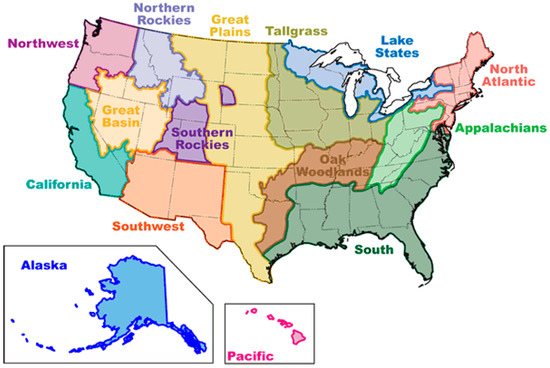
Figure 1.
The Great Plains includes portions of 10 states (Montana, North Dakota, Wyoming, South Dakota, Nebraska, Colorado, Kansas, New Mexico, Oklahoma, and Texas). Map credit: The Great Plains Fire Science Exchange.
2.2. Prescribed Fire Data
Prescribed fire is a long-established land management practice in the Flint Hills region (Figure 2), which includes most of eastern Kansas and northern Oklahoma. On average, approximately 0.8 million hectares are intentionally burned in the region each year, with most prescribed fires occurring during April. To quantify prescribed fire activities, we used a remotely sensed burned area dataset derived from the Moderate-Resolution Imaging Spectroradiometer (MODIS) onboard National Aeronautics and Space Administration (NASA)’s Terra and Aqua satellites [16]. This dataset, which covers the 17 Flint Hill counties from 2003 to 2019, was generated using a supervised minimum distance classification of bi-spectral MODIS imagery. MODIS on these satellites is making daily observations of the Earth with 36 channels spanning the spectral range from 0.41 to 15 µm and representing three spatial resolutions: 250 m (2 channels), 500 m (5 channels), and 1 km (29 channels) [21]. A combination of band 1 red (620–670 nm) and band 2 near-infrared (841–876 nm) at a spatial resolution of 250 m was used in our study because it offers the optimal combination of spatial, temporal, and spectral properties for this application. The MODIS-based daily burned area captures both prescribed and unplanned fire events across the region. For our analysis, we integrated this dataset with reported wildfire burned area data in the Flint Hills region to enable the comparative assessments of prescribed fires and wildfires.
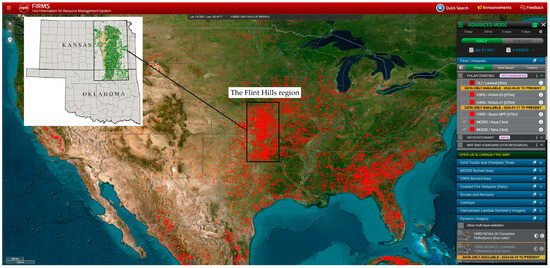
Figure 2.
Prescribed fires in the Flint Hills region (map shows NASA satellite image of fires/hotspots in red dots in April, 2021).
2.3. Long-Term and Mid-Term Risk Factors
To characterize long-term and mid-term fire risk factors, we obtained data from the Keetch–Byram Drought Index (KBDI) and grassland curing data from the Oklahoma Mesonet network for the years 2006 to 2019. The KBDI is a slow-response drought index developed by the USDA Forest Service to quantify seasonal soil moisture depletion, particularly in forested ecosystems [22]. The index ranges from zero, the point of saturation, to 800, the maximum soil moisture deficiency, and represents the amounts of rainfall required (from 0 to 8 inches) to return the soil to saturation. Over the past five decades, KBDI has become one of the most widely used indicators for wildfire monitoring and prediction [23,24]. However, given that it was originally designed for forest landscapes, its applicability to grassland ecosystems, such as those in the Great Plains, requires further evaluation. Grassland curing, defined as the proportion of dead material within a grassland fuel complex, is a critical factor in grassland fire behavior. Curing levels range from 0 to 100%, with 0% representing premature, green grass, and 100% representing fully cured, dry grass. Cured grasses are prone to fire ignition because it is more flammable than green grasses. The levels of grassland curing affect the moisture content of fuel and directly affects fire behavior and potential fire spread. Fires can barely spread at curing levels below 50%, but can spread rapidly when curing exceeds 90% [25]. Therefore, it is an important factor for determining fire danger levels in grasslands [26]. Grassland curing can be estimated from satellite-derived vegetation greenness metrics, particularly the Normalized Difference Vegetation Index (NDVI) [27]. KBDI and grassland curing levels were included in our analysis as proxies for long-term and mid-term fire risk, respectively.
3. Results
3.1. Wildfire Statistics
Between 1992 and 2020, the Great Plains experienced approximately 498,000 wildfires, burning a cumulative area of about 18 million ha. On average, this equates to roughly 17,000 wildfires and 0.6 million ha burned per year. The mean wildfire size across the ten Great Plains states was approximately 36 ha per incident (Table 1).

Table 1.
Wildfire summary in the Great Plains by state (1992–2020).
Both the total number of wildfires and the annual burned area in the Great Plains increased approximately threefold from 1992 to 2020 (Figure 3). Substantial increases in the maximum fire size were observed during major drought years, including 2000, 2006, and 2011–2012. During these periods, both the number of wildfires and the total area burned surged, while year-to-year variability in area burned was higher (lower R2) compared to variability in the number of fire incidents.
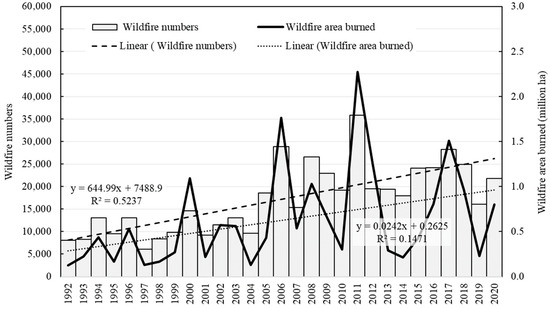
Figure 3.
Trends in wildfire frequency and burned area in the Great Plains, 1992–2020.
3.2. KBDI vs. Annual Wildfires in the Great Plains
Figure 4 highlights the positive correlation between annual average KBDI and wildfire activities in the Great Plains. While both wildfire frequency and wildfire size increase with rising KBDI, compared to wildfire frequency, wildfire size is more sensitive to drought conditions. For example, as the annual average KBDI increases from 150 to 350, the number of wildfires rises by approximately 25%, while average wildfire size doubles, from around 30 ha to 60 ha. Consequently, total area burned at a KBDI of 350 is 2.5 times greater than at a KBDI of 150.

Figure 4.
Annual wildfires vs. annual average KBDI, 20062019. (Wildfire numbers, area burned, and average sizes are for the 10 Great Plains states. The annual average KBDI was from Oklahoma Mesonet stations).
3.3. Grass Curing vs. Monthly Wildfire in Oklahoma
Figure 5 shows the multi-year average monthly wildfire numbers (1992–2020) in Oklahoma aligned with multi-year average grass curing levels. Regression analysis indicates that grass curing explains approximately 60% of the variability in monthly wildfire occurrences, highlighting its role as a significant mid-term fire risk factor in grassland ecosystems.
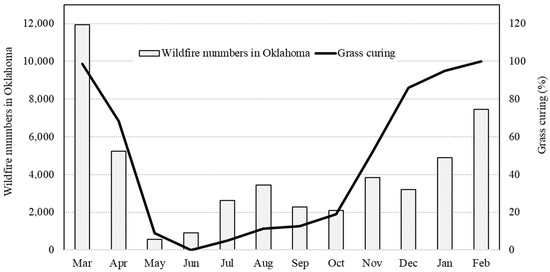
Figure 5.
Wildfire numbers and grass curing in Oklahoma.
3.4. Prescribed Fires vs. Wildfires in the Flint Hills Region
On average, 0.8 million ha of rangeland was burned by more than 2000 prescribed fires annually in spring in the 17 counties of the Flint Hills region from 2003 to 2019. Figure 6a compares the total area burned and the wildfire area burned during spring in the Flint Hills region. On average, wildfires accounted for only about 1% of the total burned area in spring (March, April, May). The R2 between wildfire area burned and total area burned in spring was only 0.08. Figure 6b illustrates the relationship between the total area burned in spring and the wildfire area burned in the following summer (June, July, August). Generally, years with larger spring burn areas, primarily due to prescribed fires, corresponded to reduced wildfire activity in summer, with the exception of 2007 and 2013. In both years, fires were limited in both seasons, likely due to diminished fine fuel loads following preceding severe droughts. In other years, a negative relationship (R2 = 0.26) was observed between the total area burned in spring and the wildfire area burned in summer.
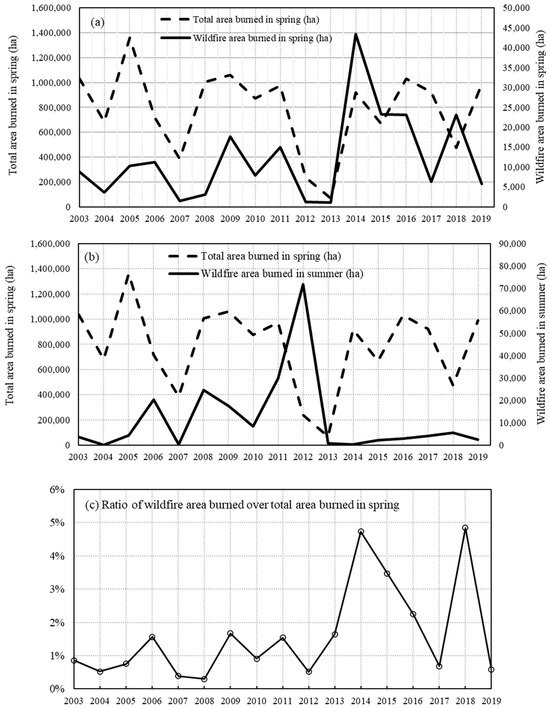
Figure 6.
The comparison of the total area burned and the wildfire area burned in the Flint Hills region (2003–2019). (a) Total area burned in spring vs. wildfire area burned in spring; (b) Total area burned in spring vs. wildfire area burned in summer; (c) Ratio of wildfire area burned over total area burned in spring.
To assess fire risk during the spring prescribed fire season, the ratio of wildfire area burned to total area burned was calculated. As shown in Figure 6c, this ratio displayed an increasing trend from 2003 to 2019, suggesting rising fire risk in the Flint Hills region, which could make the implementation of prescribed fires more challenging due to growing safety concerns.
Figure 7a presents the multi-year average of daily wildfire and total area burned. Both metrics followed a bell-shaped distribution, with wildfire activity peaking around March 22 and total burn area peaking around April 10. Typically, more prescribed fires usually indicate weather and fuel conditions with lower fire risks, while more wildfires usually indicate conditions with higher fire risks. The ratio of wildfire area burned to total area burned varied by the day of year. Figure 7b shows the ratio of daily wildfire area burned to total area burned throughout the spring season. The ratio declines steadily over time, from more than 20% in early March to less than 1% by early April, highlighting a sharp decrease in fire risk as spring progresses.
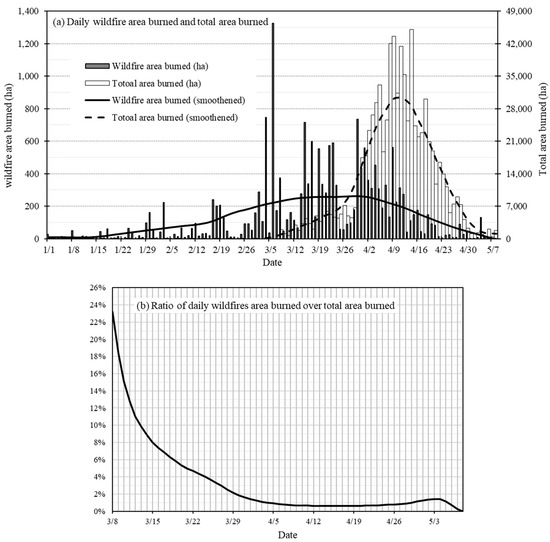
Figure 7.
(a) Multi-year average daily wildfire area burned and total area burned on different dates in the Flint Hills region. (b) The ratio of multi-year average daily wildfire area burned (smoothened data) over total area burned (smoothened data) on different dates.
4. Discussion
4.1. General Trends of Wildfires in the Great Plains
This study analyzed the historical wildfire data from 1992 to 2020 to characterize wildfire risk across the Great Plains. The results show that wildfire frequency generally increases from north to south, likely driven by increasing temperature, while average wildfire size increases from east to west due to differences in dominant land cover types. The average wildfire size per burn was notably larger in Montana, Wyoming, and New Mexico (Figure 8a). This pattern is likely due to the greater prevalence of woody vegetation in these mountainous western states, which is more conducive to extreme wildfire behavior compared to other land-use types in the region [28]. The distribution of land-use types in the Great Plains is described in Donovan et al. [28]. As also reported by Scasta et al. [29], wildfire frequency generally increases from north to south, driven by rising temperatures. Texas, in particular, exhibits the highest wildfire frequency. As a result, both the western and southern Great Plains states tend to have larger annual burned areas (Figure 8b).
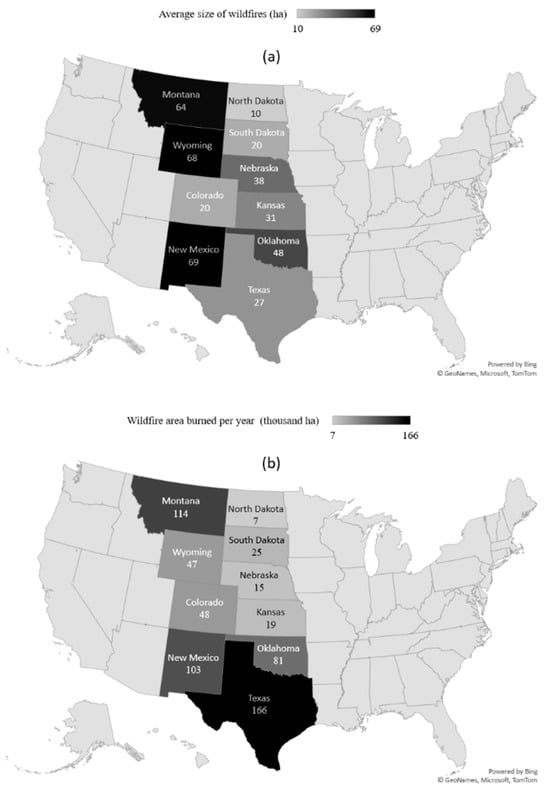
Figure 8.
Average wildfire size per incident (a) and average annual burned area (b) across the Great Plains, 1992–2020.
Both wildfire frequency and total area burned exhibited clear upward trends during the study period, consistent with findings from other regions in the western United States [30,31,32,33]. The observed increasing trend of wildfires in the Great Plains is consistent with Donovan et al. [34], who reported a fourfold increase in the area burned by large wildfires (>400 ha) between 1985 and 2014 using hurdle models. These results also align with recent findings based on satellite observations [30,31], wildfire reports [32], and simulation models [33], all of which suggest an upward trend in wildfire activity across the western United States. While Yu et al. [6] noted that the increase in total burned area has outpaced the rise in wildfire frequency, implying larger average fire sizes, the data for the Great Plains do not show a significant increase in mean fire size.
The increasing trend in wildfire activities is likely driven by multiple factors, including climate change, particularly warmer and drier conditions that lead to drier vegetation and extended fire seasons [4,30,35,36]. The increasing frequency and size of large wildfires have been linked to intensifying drought severity [30,36]. Our correlation analysis further revealed that severe droughts had a stronger effect on increasing fire size than fire frequency (Figure 4). Human factors, such as population growth near wildland areas [37] and fire suppression policies that lead to fuel accumulation [38], may also play a role in escalating wildfire risks.
4.2. Seasonal Pattern of Wildfires in the Great Plains
Seasonal wildfire patterns in the Great Plains vary geographically and are influenced by differences in land cover. In the western Great Plains, wildfire occurrences typically peak in summer, whereas in the eastern states, peak wildfire activity occurs in spring (Figure 9a). This contrast likely reflects differences in dominant vegetation types, woody vegetation in the west versus grasslands in the east. Yu et al. [6] identified a bimodal seasonal distribution of wildfires across the U.S., with a primary peak in August and a secondary peak in April, a pattern consistent with findings from this study. The summer wildfire peak is likely driven by convective storms and frequent lightning strikes [39]. In contrast, in grassland regions, the wildfire peak often occurs in spring before grasses become green, as dormant grasses are more flammable than actively growing grasses. Wildfire size also exhibits distinct seasonal patterns by region. In the southern Great Plains states (Texas, New Mexico, Oklahoma, and Kansas), wildfires are the largest in spring, about 1 to 2 times larger than in other seasons (Figure 9b). In contrast, northern states such as Wyoming and Montana wildfire sizes peak in summer. Notably, in Oklahoma and Kansas, both wildfire numbers and sizes peak in spring, indicating that wildfire risk is the highest during that season. In Texas, while most wildfires occur in summer, the largest total area burned is recorded in spring.
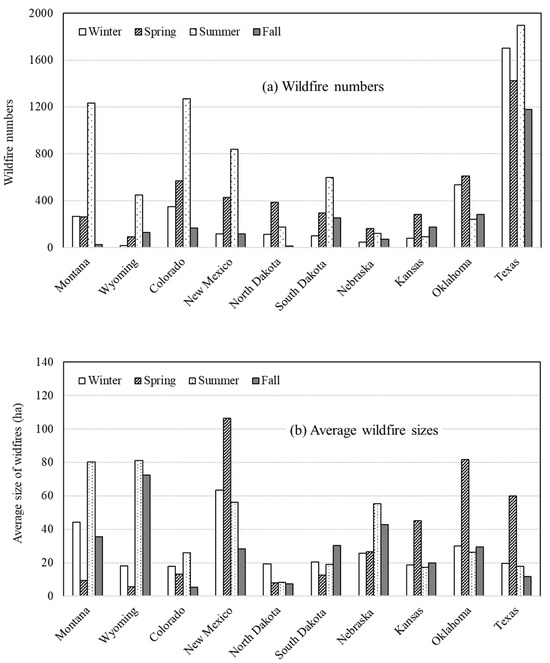
Figure 9.
The seasonal pattern of wildfire numbers (a) and average wildfire sizes per incident (b) in the Great Plains, 1992–2020.
One notable impact of climate change is a temporal shift in the wildfire season across the Great Plains. In northern states such as Montana and Wyoming, the peak month for area burned has moved from August to July, as evidenced by increasing trends in July and declining trends in August. Similarly, in southern states such as New Mexico and Colorado, the peak shifted from July to June. In grassland regions such as the Flint Hills, the spring fire peaks are also gradually occurring earlier. In Oklahoma and Kansas, wildfire activity increased in February and March while remaining relatively stable in April, suggesting a gradual shift in the wildfire season toward earlier months. Also, Figure 6a,b reveal a seasonal shift in wildfire activities in the Flint Hills region after 2013, with more wildfires occurring in spring rather than summer. This is consistent with the general observations that wildfire activities gradually moved to earlier months in the year. These changes likely reflect the effects of climate change, which has resulted in the earlier onset of hot and dry conditions. As also noted by Scasta et al. [29], such seasonal shifts are especially apparent in cooler, high-latitude, and high-elevation regions like Montana and Wyoming. This evolving pattern is important for strategic wildfire preparedness, resource allocation, and planning prescribed fire windows.
4.3. Long-Term, Mid-Term, and Short-Term Risk Factors
Wildfire activity is influenced by risk factors operating on multiple timescales. The interannual variability in wildfires can be linked to the severity of drought conditions in a given year. The KBDI, which reflects soil moisture deficit, serves as a strong indicator of drought severity. A higher annual average KBDI generally corresponds to larger average wildfire sizes and greater wildfire frequency and, therefore, a greater total area burned. In this study, the annual average KBDI explains 51% of the interannual variability in total area burned, making it a critical long-term risk factor for wildfires. KBDI has been widely used to model wildfire potential [40,41]. Abatzoglou and Williams [42] reported R2 values ranging from 0.6 to 0.8 between KBDI and area burned across southwestern U.S. forests, compared to 0.51 in this study of the Great Plains. However, other factors, such as fuel accumulation, also contribute to interannual variability in wildfires. Fuel accumulation is influenced by the timing and amount of precipitation during the growing season, regardless of the current drought severity. Scasta et al. [29] found that, in Oklahoma and Wyoming, the most severe wildfire seasons often followed years with average or above-average precipitation, while in Nevada, wildfire activity was linked to precipitation from the previous year. These dynamics may explain why the relationship between KBDI and area burned tends to be more robust at broader spatial scales [6]. The R2 between KBDI and area burned across the entire Great Plains is higher than that for the correlations found within individual states, suggesting that localized differences in fuel conditions and other factors introduce uncertainty in smaller-scale assessments.
Grass curing, a mid-term risk factor, explained 60% of monthly wildfire variability in grasslands. However, grass curing alone does not fully explain seasonal wildfire patterns. For instance, as shown in Figure 5, wildfire numbers in July and August are substantially higher than in May and June, despite all four months exhibiting similar low grass curing levels (<20%). This discrepancy is likely due to higher temperatures and increased lightning activity during midsummer. Conversely, significantly fewer wildfires occur in December to February than in March, even though all these months exhibit similar high grass curing levels (>80%). This is likely due to lower winter temperatures, which reduce ignition potential despite high fuel dryness. The variation in seasonal fire risk could be simulated using grass curing and temperature as two predictors.
Short-term risk factors, such as wind speed and dead fuel moisture, largely determined by daily relative humidity and temperature fluctuations, also play a critical role in fire ignition and spread [43]. Ongoing research aims to integrate all the long-term, mid-term, and short-term risk factors into a comprehensive fire risk assessment tool for both wildfire response and prescribed fire planning.
Additionally, the sharp increase in wildfire numbers in March raises questions about the influence of prescribed fire practices, which are commonly conducted in early spring. Further investigation is warranted to determine the extent to which these prescribed fires contribute to wildfire statistics during that period.
4.4. Relationship Between Wildfires and Prescribed Fires
Prescribed fire is a well-established land management practice in the Great Plains, crucial for reducing fuel loads and mitigating wildfire risk. As wildfire occurrence and WUI expansion increase, the importance of prescribed fire continues to grow. In the Flint Hills region of eastern Kansas and northern Oklahoma, spring serves as the primary seasonal window for prescribed fires. The weak positive correlation between wildfire area burned and total area burned in spring suggests that prescribed fire activity explains only 8% of the variation in wildfire activity. This finding aligns with that of Reid [3], who reported that prescribed fire ignitions contribute the least among known ignition sources, ranging from 0 to 13.2%. Similarly, Toledo et al. [44] found that wildfire risk was only marginally associated with prescribed fire use, based on a structural equation model. Also, as shown in Figure 7, March experienced significantly more wildfire activity than April, even though prescribed fire activity peaked in April. This suggests that wildfire occurrence is more strongly influenced by grass curing status than by prescribed fire operations.
Although the correlation between prescribed fire activity and wildfires in spring was weak (R2 = 0.08), prescribed burning in spring showed a stronger negative relationship with wildfire activity in summer (R2 = 0.26), indicating that prescribed fires in spring may help mitigate summer wildfire risk. These findings support previous studies [44] that claimed prescribed fire can play a meaningful role in risk reduction when applied effectively.
Since prescribed fires typically occur during periods of lower fire risk, while wildfires tend to emerge under higher-risk conditions, to better quantify fire risk during the spring burning season, this study calculated the ratio of wildfire area burned to total area burned (dominated by prescribed fires) for the springs of 2003–2019. On average, this ratio declined from more than 20% in early March to less than 1% by early April, indicating the seasonal decline in fire risk. This decline is most likely linked to the gradual reduction in grass curing, which typically drops from 100% in winter to nearly 0% in summer. Interestingly, the ratio begins to rise again in early May (Figure 9b), when grass curing is at its minimum and relatively stable. This secondary rise in fire risk could be attributed to short-term weather factors such as increased thunderstorm activity, lightning frequency, or stronger wind speeds in late spring.
5. Conclusions
The fear related to fire risk is the main reason that hinders the use of prescribed fire by landowners [12]. The quantification of this risk is the first step to manage the risk and to lower the barriers for the use of prescribed fire. The limited use of prescribed fire is often attributed to resource constraints and a lack of confidence among landowners. Expanding the use of prescribed fire will require accessible, science-based tools for assessing and managing fire risk. By improving the understanding of when and where prescribed fire can be safely used, landowners, especially those with less experience, can adopt this practice with greater confidence. The results of this study will lay a foundation for the development of a localized fire risk assessment tool that integrates various long-term, mid-term, and short-term risk factors, and support more effective fire management in this region. Ultimately, proactive and informed prescribed fire use holds promise for enhancing landscape resilience and reducing wildfire risk in the Great Plains.
Author Contributions
Data curation, I.O.O. and M.B.G.; Writing—original draft, Z.L. All authors have read and agreed to the published version of the manuscript.
Funding
This research was funded by National Science Foundation, grant number 2306603 (SCC-IRG Track 1: Smart and Safe Prescribed Burning for Rangeland and Wildland Urban Interface Communities).
Institutional Review Board Statement
Not applicable.
Informed Consent Statement
Not applicable.
Data Availability Statement
The raw data supporting the conclusions of this article will be made available by the authors on request.
Acknowledgments
Contribution no. 25-241-J from the Kansas Agricultural Experiment Station. The study is also supported by Grassland Heritage Foundation scholarship as a partial source of funds.
Conflicts of Interest
The authors declare no conflicts of interest. The funders had no role in the design of the study; in the collection, analyses, or interpretation of data; in the writing of the manuscript; or in the decision to publish the results.
Abbreviations
The following abbreviations are used in this manuscript:
| GFDI | Grassland Fire Danger Index |
| ha | hectares |
| KBDI | Keetch–Byram Drought Index |
| MODIS | Moderate-Resolution Imaging Spectroradiometer |
| NASA | National Aeronautics and Space Administration |
| NDVI | Normalized Difference Vegetation Index |
| WUI | wildland–urban interface |
References
- Ojima, D.S.; Conant, R.T.; Parton, W.J.; Lackett, J.M.; Even, T.L. Recent climate changes across the Great Plains and implications for natural resource management practices. Rangel. Ecol. Manag. 2021, 78, 180–190. [Google Scholar] [CrossRef]
- Stubbendieck, J.; Volesky, J.D.; Ortmann, J. Grassland Management with Prescribed Fire; Nebraska Forest Service Publications 42; University of Nebraska-Lincoln: Lincoln, NE, USA, 2007; Available online: https://digitalcommons.unl.edu/nebforestpubs/42 (accessed on 12 April 2025).
- Reid, A.M. Conservation and Fire Management of Great Plains Landscapes. Doctoral Thesis, Oklahoma State University, Stillwater, OK, USA, 2009. [Google Scholar]
- Russell, A.; Fontana, N.; Hoecker, T.; Kamanu, A.; Majumder, R.; Stephens, J.; Young, A.M.; Cravens, A.E.; Giardina, C.; Hiers, K.; et al. A fire-use decision model to improve the United States’ wildfire management and support climate change adaptation. Cell Rep. Sustain. 2024, 1, 100125. [Google Scholar] [CrossRef]
- Brunson, M. Public perceptions and tradeoffs in using prescribed fire to reduce wildfire risk. West. Econ. Forum 2023, 16, 53–64. [Google Scholar] [CrossRef]
- Yu, G.; Feng, Y.; Wang, J.; Wright, D.B. Performance of fire danger indices and their utility in predicting future wildfire danger over the conterminous United States. Earth’s Future 2023, 11, e2023EF003823. [Google Scholar] [CrossRef]
- Higgins, K.F.; Kruse, A.D.; Piehl, J.L. Prescribed Burning Guidelines in the Northern Great Plains. U.S. Fish and Wildlife Service; South Dakota State University Cooperative Extension Service: Brookings, SD, USA, 1989; Available online: http://openprairie.sdstate.edu/extension_circ/430 (accessed on 12 April 2025).
- Leis, S.A. Fuels management in the Great Plains. GPE Publ. 2013, 28. Available online: https://gpfirescience.org/wp-content/uploads/2022/05/GPEFuelsManLeis201328-3.pdf (accessed on 12 April 2025).
- Watts, M.; Russell, A.; Adhikari, S.; Weir, J.; Joshi, O. Analysis of the cost and cost components of conducting prescribed fires in the Great Plains. Rangel. Ecol. Manag. 2024, 92, 146–153. [Google Scholar] [CrossRef]
- Kreuter, U.P.; Treadwell, M.L.; Wonkka, C.L.; Toledo, D.; Stroman, D.L.; Twidwell, D. Fighting wildfire with prescribed fire in the Southern Great Plains, USA: Liability, regulatory and social factors. IGC Proc. (1989–2023) 2021, 28. [Google Scholar]
- Clark, A.S.; McGranahan, D.A.; Geaumont, B.A.; Wonkka, C.L.; Ott, J.P.; Kreuter, U.P. Barriers to prescribed fire in the US Great Plains, Part I: Systematic review of socio-ecological research. Land 2022, 11, 1521. [Google Scholar] [CrossRef]
- Hanberry, B.; Reeves, M.C.; Brischke, A.; Hannemann, M.; Hudson, T.; Mayberry, R.; Ojima, D.; Prendeville, H.R.; Rangwala, I. Managing effects of drought in the Great Plains. In Effects of Drought on Forests and Rangelands in the United States: Translating Science into Management Responses; Gen. Tech. Rep. WO-98; Vose, J.M., Peterson, D.L., Luce, C.H., Patel-Weynand, T., Eds.; USDA Forest Service: Washington, DC, USA, 2019; pp. 141–164. [Google Scholar]
- Huffman, M.R. Making a world of difference in fire and climate change. Fire Ecol. 2014, 10, 90–101. [Google Scholar] [CrossRef]
- Chiodi, A.M.; Larkin, N.S.; Varner, J.M. An analysis of Southeastern US prescribed burn weather windows: Seasonal variability and El Niño associations. Int. J. Wildl. Fire 2018, 27, 176–189. [Google Scholar] [CrossRef]
- Yurkonis, K.A.; Dillon, J.; McGranahan, D.A.; Toledo, D.; Goodwin, B.J. Seasonality of prescribed fire weather windows and predicted fire behavior in the northern Great Plains, USA. Fire Ecol. 2019, 15, 7. [Google Scholar] [CrossRef]
- Akinbile, D.S.; Liu, Z.; Lin, X.; Moore, T.; Song, W. Optimum weather conditions for prescribed burning in the Flint Hills Region. J. ASABE 2023, 66, 647–656. [Google Scholar] [CrossRef]
- Schreck, M.B.; Howerton, P.J.; Cook, K.R. Adapting Australia’s grassland fire danger index for the United States’ central plains. In Central Region Technical Attachment; National Weather Service: Silver Spring, MD, USA, 2010; p. 10-02. Available online: https://www.weather.gov/media/crh/publications/TA/TA_1002.pdf (accessed on 12 April 2025).
- Short, K.C. Spatial Wildfire Occurrence Data for the United States, 1992–2020 [FPA FOD 20221014]; Forest Service Research Data Archive: Fort Collins, CO, USA, 2022. [Google Scholar] [CrossRef]
- Walker, K. tigris: An R Package to Access and Work with Geographic Data from the US Census Bureau. R J. 2016, 8, 231. [Google Scholar] [CrossRef]
- Pebesma, E. Simple Features for R: Standardized Support for Spatial Vector Data. R J. 2018, 10, 439. [Google Scholar] [CrossRef]
- Remer, L.A.; Kaufman, Y.J.; Tanré, D.; Mattoo, S.; Chu, D.A.; Martins, J.V.; Li, R.R.; Ichoku, C.; Levy, R.C.; Kleidman, R.G.; et al. The MODIS aerosol algorithm, products, and validation. J. Atmos. Sci. 2005, 62, 947–973. [Google Scholar] [CrossRef]
- Keetch, J.J.; Byram, G.M. A drought index for forest fire control. In USDA Forest Service Research Paper SE-38; Southeastern Forest Experiment Station: Asheville, NC, USA, 1968. [Google Scholar]
- Krueger, E.S.; Levi, M.R.; Achieng, K.O.; Bolten, J.D.; Carlson, J.D.; Coops, N.C.; Holden, Z.A.; Magi, B.I.; Rigden, A.J.; Ochsner, T.E. Using soil moisture information to better understand and predict wildfire danger: A review of recent developments and outstanding questions. Int. J. Wildl. Fire 2022, 32, 111–132. [Google Scholar] [CrossRef]
- Plucinski, M.P.; Tartaglia, E.; Huston, C.; Stephenson, A.G.; Dunstall, S.; McCarthy, N.F.; Deutsch, S. Exploring the influence of the Keetch–Byram Drought Index and McArthur’s Drought Factor on wildfire incidence in Victoria, Australia. Int. J. Wildl. Fire 2023, 33, 1–9. [Google Scholar] [CrossRef]
- Sullivan, A.L. Grassland fire management in future climate. United_Nation_2021_Wildfires—A growing concern for sustainable development. Adv. Agron. 2010, 106, 173–208. [Google Scholar] [CrossRef]
- Anderson, S.A.; Anderson, W.R.; Hollis, J.J.; Botha, E.J. A simple method for field-based grassland curing assessment. Int. J. Wildl. Fire 2011, 20, 804–814. [Google Scholar] [CrossRef]
- Newnham, G.J.; Verbesselt, J.; Grant, I.F.; Anderson, S.A. Relative Greenness Index for assessing curing of grassland fuel. Remote Sens. Environ. 2011, 115, 1456–1463. [Google Scholar] [CrossRef]
- Donovan, V.M.; Wonkka, C.L.; Wedin, D.A.; Twidwell, D. Land-use type as a driver of large wildfire occurrence in the US Great Plains. Remote Sens. 2020, 12, 1869. [Google Scholar] [CrossRef]
- Scasta, J.D.; Weir, J.R.; Stambaugh, M.C. Droughts and wildfires in western U.S. rangelands. Rangelands 2016, 38, 197–203. [Google Scholar] [CrossRef]
- Dennison, P.E.; Brewer, S.C.; Arnold, J.D.; Moritz, M.A. Large wildfire trends in the western United States, 1984–2011. Geophys. Res. Lett. 2014, 41, 2928–2933. [Google Scholar] [CrossRef]
- Iglesias, V.; Balch, J.K.; Travis, W.R. U.S. fires became larger, more frequent, and more widespread in the 2000s. Sci. Adv. 2022, 8, eabc0020. [Google Scholar] [CrossRef]
- Westerling, A.L. Increasing western U.S. forest wildfire activity: Sensitivity to changes in the timing of spring. Philos. Trans. R. Soc. B Biol. Sci. 2016, 371, 20150178. [Google Scholar] [CrossRef]
- Boisramé, G.F.; Brown, T.J.; Bachelet, D.M. Trends in western USA fire fuels using historical data and modeling. Fire Ecol. 2022, 18, 8. [Google Scholar] [CrossRef]
- Donovan, V.M.; Wonkka, C.L.; Twidwell, D. Surging wildfire activity in a grassland biome. Geophys. Res. Lett. 2017, 44, 5986–5993. [Google Scholar] [CrossRef]
- Lang, Y.; Moeini-Meybodi, H. Wildfires—A Growing Concern for Sustainable Development; United Nations Department of Economic and Social Affairs: New York, NY, USA, 2021; Available online: https://www.un.org/development/desa/dpad/wp-content/uploads/sites/45/publication/PB_111.pdf (accessed on 12 April 2025).
- Gamelin, B.L.; Feinstein, J.; Wang, J.; Bessac, J.; Yan, E.; Kotamarthi, V.R. Projected U.S. drought extremes through the twenty-first century with vapor pressure deficit. Sci. Rep. 2022, 12, 8615. [Google Scholar] [CrossRef]
- Cooke, B.; Williams, D.; Paveglio, T.; Carroll, M. Living with fire: How social scientists are helping wildland-urban interface communities reduce wildfire risk. Sci. You Can Use Bull. 2016, 19, 9. [Google Scholar]
- Brotons, L.; Aquilué, N.; De Cáceres, M.; Fortin, M.J.; Fall, A. How fire history, fire suppression practices and climate change affect wildfire regimes in Mediterranean landscapes. PLoS ONE 2013, 8, e62392. [Google Scholar] [CrossRef]
- Balch, J.K.; Bradley, B.A.; Abatzoglou, J.T.; Nagy, R.C.; Fusco, E.J.; Mahood, A.L. Human-started wildfires expand the fire niche across the United States. Proc. Natl. Acad. Sci. USA 2017, 114, 2946–2951. [Google Scholar] [CrossRef]
- Dolling, K.; Chu, P.S.; Fujioka, F. A climatological study of the Keetch/Byram drought index and fire activity in the Hawaiian Islands. Agric. For. Meteorol. 2005, 133, 17–27. [Google Scholar] [CrossRef]
- Brown, E.K.; Wang, J.; Feng, Y. U.S. wildfire potential: A historical view and future projection using high-resolution climate data. Environ. Res. Lett. 2021, 16, 034060. [Google Scholar] [CrossRef]
- Abatzoglou, J.T.; Williams, A.P. Impact of anthropogenic climate change on wildfire across the western U.S. forests. Proc. Natl. Acad. Sci. USA 2016, 113, 11770–11775. [Google Scholar] [CrossRef] [PubMed]
- Wade, D. Fuel moisture and prescribed burning. South. Fire Exch. Fact Sheet 2013, 5, 5–8. Available online: https://southernfireexchange.org/wp-content/uploads/2013-5.pdf (accessed on 12 April 2025).
- Toledo, D.; Kreuter, U.P.; Sorice, M.G.; Taylor, C.A., Jr. The role of prescribed burn associations in the application of prescribed fires in rangeland ecosystems. J. Environ. Manag. 2014, 132, 323–328. [Google Scholar] [CrossRef]
Disclaimer/Publisher’s Note: The statements, opinions and data contained in all publications are solely those of the individual author(s) and contributor(s) and not of MDPI and/or the editor(s). MDPI and/or the editor(s) disclaim responsibility for any injury to people or property resulting from any ideas, methods, instructions or products referred to in the content. |
© 2025 by the authors. Licensee MDPI, Basel, Switzerland. This article is an open access article distributed under the terms and conditions of the Creative Commons Attribution (CC BY) license (https://creativecommons.org/licenses/by/4.0/).